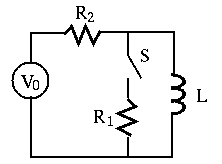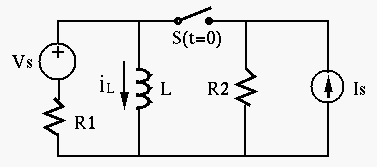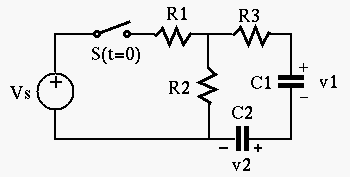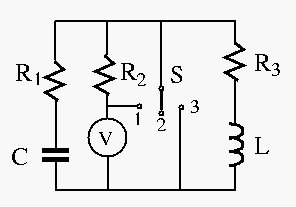


Next: About this document ...
E84 Home Work 7
- Find the current
 through resistor
through resistor  after the
switch is closed at
after the
switch is closed at  , assuming the input is a DC voltage and the
circuit is already in steady state before
, assuming the input is a DC voltage and the
circuit is already in steady state before  .
(Hint: current through an inductor cannot change instantaneously.)
.
(Hint: current through an inductor cannot change instantaneously.)

- In the circuit below,
 ,
,  ,
,  ,
,
 ,
,  . Assume before the switch is closed at
. Assume before the switch is closed at  , the
system is already stablized. Find current
, the
system is already stablized. Find current  through
through  and
voltage
and
voltage  across
across  .
.

- In the circuit below,
 ,
,  ,
,  ,
,
 ,
,  ,
,  . Assume before the switch
is closed at
. Assume before the switch
is closed at  , the system is already stablized. Find voltages
, the system is already stablized. Find voltages
 and
and  across capacitors
across capacitors  and
and  , respectively.
(Hint,
, respectively.
(Hint,  and
and  are two capacitors in series with an equivalent
capacitance is
are two capacitors in series with an equivalent
capacitance is
 .
.  and
and  have share the same
time constant
have share the same
time constant  .)
.)

- In the circuit below,
 ,
,  ,
,  ,
,
 ,
,  ,
,  . The circuit is in steady state initially when
the switch is at position 2 (not connected). Find
. The circuit is in steady state initially when
the switch is at position 2 (not connected). Find  and
and  for the
following two independent cases:
for the
following two independent cases:
- after the switch is changed to position 1 at
 ;
;
- after the switch is changed to position 3 at
 ;
;




Next: About this document ...
Ruye Wang
2008-03-19



 ;
;
 ;
;




